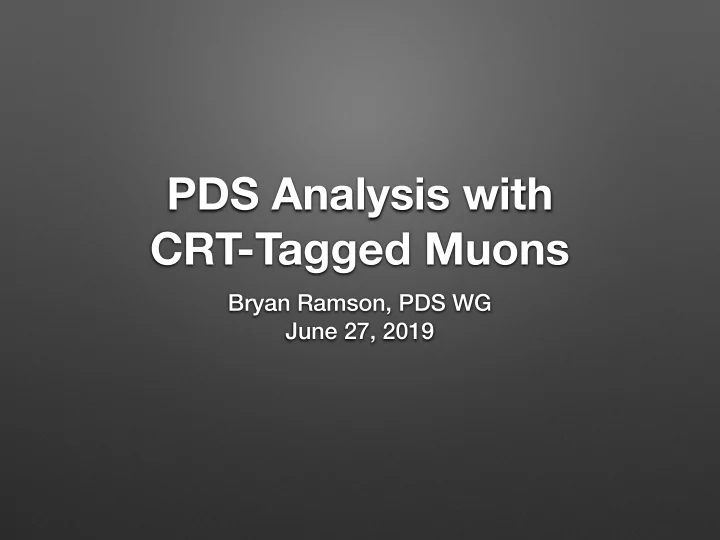

PDS Analysis with CRT-Tagged Muons Bryan Ramson, PDS WG June 27, 2019
Refresher on Method • CTB collects fragments from all subsystems on CRT “pixel” coincidence (US+DS with 60 ns) • Comparison to pixel centers gives rough positioning of track in TPC at trigger issuance Photon Detection System Timing Schematic External Trigger (From DAQ/CTB) Experiment Timestamp 50 Mhz -250 us +2.5 ms Data Collection Window SSP External Timestamp 50 Mhz SSP Internal Timestamp 150 Mhz External Trigger (Inside SSP) 13.3 us Internal Triggers (Inside SSP) 13.3 us 13.3 us 13.3 us 13.3 us 13.3 us
Dataset Was able to get data for four months of running: November 2018 February 2019 RUN DATE SIZE RUN DATE SIZE 11/05/18 2202 5785-5786 6696,6698, 2/7/19 2373 6700 11/12/18 330 5851 2/12/19 476 6776 Total of 23,163 December 2018 2/14/19 1413 6812 total files RUN DATE SIZE 2/18/19 1472 6834-6835 ~1.5 Million 12/10/18 1667 6119-6120 2/19/19 2802 6836-6838 triggers 6129,6141, 6156,6191 12/11/18 1865 2/20/19 2049 6856 12/14/18 1845 6200-6202 2/21/19 2536 6872-6874 January 2019 6909, 2/27/19 1485 RUN DATE SIZE 6912-6913 2/28/19 397 6927 1/22/19 1520 6509
PDS Stability Stability by technology shows ARAPUCA is most stable, other technologies ~2-4% Stability initially shows some z- dependence (space charge)? Top of detector less consistent than bottom over months (also space charge)?
Pair Trigger Characteristics ~98,000 throughgoing tracks, ~75,000 hair • Most populated pair has 7,600 trails • 1:25 DAQ Side:Rack Side •
Track Characteristics • Characteristic downward direction due to trigger masking Majority of tracks are directly in front of the PDS •
Base Light Characteristics Descriptive Stats T = exp ( C 0 − λ x ) TECH AVG STDDEV 20.24 17.19 SENSL+DC exp ( C 0 ) = 8.07 ± 0.04 37.61 27.49 MPPC+DC 84.22 79.39 SENSL+DS λ = 0.009 ± 0.003 256.38 201.62 MPPC+DS 689.23 630.13 ARAPUCA
Comparison to Monte Carlo First threw flat MC through the TPC: T = exp ( C 0 − λ x ) exp ( C 0 ) = 7.33 ± 0.05 λ MC = 0.015 ± 0.001 λ = 0.009 ± 0.003 Is this geometry or an attenuation problem?
Comparison to Monte Carlo Threw MC with random angle distribution corresponding to CTB Pixel channels 12 & 25: Note: this data sample used for stability calculation
Comparison to Monte Carlo λ = 0.011 ± 0.001 λ MC = 0.014 ± 0.001
Trajectory Matching MC • Matching trajectory and position goes a long way towards making the MC agree with data. Can this be further exploited? • Pick real data and throw MC with the same angle only changing start position (event-by-event). • Uncertainty in x and y of start position 100 MC per event. (Used ~700 events). • Result should be OpDetectors in MC that are matched given a trajectory.
Early Results < PE Ara / PE S + DC > = 23.64 ± 1.78 < PE Ara / PE M + DC > = 6.46 ± 2.43 < PE Ara / PE S + DS > = 4.10 ± 2.26 < PE M + DS / PE S + DS > = 5.55 ± 2.85
Recommend
More recommend